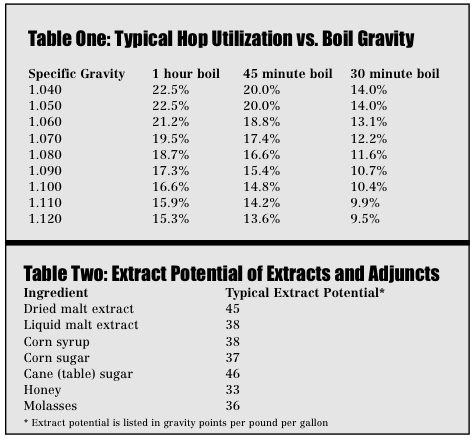6 Steps for Steeping Grains
Malt extract tastes great and from it homebrewers can make the finest beer on the planet — their own. With personal and judicious use of steeped specialty grains, brewers can make this product even finer. You can customize a brew; you can focus on nuances. And specialty grains are the way to really fine-tune malt flavor.
Back to Basics: Barley Malt
Barley malt is a germinated grass seed. (To a city person barley looks pretty much like wheat: a stalk with long, tapering leaves that grow along the stalk and a head that contains the seeds.) After harvest, maltsters germinate the seeds, or barleycorns, by moistening them and holding them within a temperature range comfortable for germination. Like any hopeful seed, barleycorns put out tiny rootlets and the “baby plant” starts to grow, until the maltster stops the growth by drying the germinated kernels.
During this malting process enzymes (the chemical triggers) develop naturally in the kernel. Enzymes allow brewers to mash the grains, which converts the starchy interior of the barleycorn to sugar. When you use malt extract, this conversion via enzymes has been done by the extract manufacturer. The sweet liquid has been run off from the husks, concentrated, and packaged for your brewing use. But barley malt can play other roles, too. Specialty grains allow brewers many more malt flavor options than does using malt extract alone. While malt extract (or base malt of some type for all-grain brewers) always provides the significant fermentables in beer, specialty grains are used for flavor, color, and body.
Specialty grains rarely make up more than 20 percent of the total weight of malt in any beer recipe. Maltsters can change the flavor of barley malt dramatically just by the different ways they handle it, and various techniques lead to different specialty grains.

Specialty Grains
Crystal Malt
This is pale malt that has been heated under moist conditions. The starch, aided by the naturally occurring enzymes developed during malting, changes to sugar. The sugar is then lightly caramelized. Taste some crystal, and look at the inside of the kernel under the husk. It’s glossy and amber-red, similar to the caramelized table sugar that you make in a skillet for desserts. When added to a beer recipe, crystal malt adds caramelly, rich flavor; body; and the same amber color you see inside the kernel. Crystal malt is the classic specialty grain in pale ales but also goes into ambers, Scotch ale, dark ales, and whatever you as the brewer want to put it in. Crystal malt can be lightly caramelized or heated more for a darker color and deeper flavor. Typically, it ranges from 10° to 160° on the Lovibond scale. Brewers generally use from one-eighth of a pound up to one pound of crystal malt for each five-gallon batch.
Chocolate Malt
When pale malt is heated in a rotating drum it begins to roast. Chocolate malt is heated under dry conditions until the entire kernel is a milk-chocolate brown color throughout. It has a wonderful roasted flavor and nothing at all to do with chocolate other than color. Brewers use chocolate malt in brown ales and dark bock beers. Some brewers put chocolate in porters for a nutty, soft roastiness that is gentle and deep. Sometimes as little as an ounce will go into a recipe, providing a bit of color, while other recipes may call for up to three-fourths of a pound for five gallons. Chocolate malt usually runs about 350° to 400° Lovibond.
Black Patent or Black Malt
Roasted in a drum until the malt flavor has pretty much turned to an astringent roastiness, black patent (BP) is used for stouts, porters, and black lagers. Use this one with caution, because it is easy to overdo it. One ounce will provide a deep red color and flavor nuances in a five-gallon batch and a half pound will make any beer black and roasty. The Lovibond rating is 500° or more.
Roasted Barley
Differs from black patent because it is made from unmalted barley. Actually more malt flavor seems to show through instead of just roast flavor. Roasted barley is almost a “must use” for stouts. Roasted barley also carries a Lovibond rating of 300° to 500° or more.
Other Specialty Grains
Victory malt and biscuit malt with their toasted flavor can be used as specialty grains. The same is true of the high (temperature) kilned malts such as Vienna and Munich; malts smoked over wood or peat; and even malted wheat or rye, which extract brewers sometimes handle like specialty grains. However, these grains can contain greater or lesser amounts of starch and if you choose to use them steeped in a malt extract-based recipe, you will risk putting starch in your beer.
Starch is a flavor you are probably not after, and it can lead to haze problems. It can also contribute to a possibly shorter shelf life because while brewer’s yeast can’t eat starch, some bacteria can and even the most sanitation-fanatic homebrewer may have a bacterium or two in the batch. Crystal, chocolate, and dark-roasted grain have no raw starch or significant enzymes left after the handling they have undergone, so they won’t lead to starch in the finished product. Of course homebrewers sometimes do steep wheat or other enzymatically active grains and achieve results they are happy with — do what you like, armed with knowledge.
The Procedure:
1. Choose a grain
Determine what flavor you’re aiming for and pick appropriate specialty grains to complement your recipe. A great way to focus on the steeping procedure is to use only one type of grain — crystal in the 60° to 80° Lovibond range, for example — in an all-extract beer you have made before, writing down the exact amount used. By adding steeped grain to a recipe you have tried before, you’ll really be able to focus on how the grain changed the flavor.
2. Prepare the grain
Have the grain milled when you purchase it, or crack it with a rolling pin at home. (This is less messy if you crack it a handful at a time in a plastic bag.) Don’t use a coffee mill; it’s important to maintain most of the integrity of the husk. This will keep sharp-tasting tannins in the husks and not in your wort. Put the cracked grain, now known as grist, into a cheesecloth or nylon mesh bag and tightly tie the top.
3. Prepare the water
Put water in your kettle and turn the heat on just as you always do. Depending on the size of your kettle, you’ll be heating 2.5 gallons of water or more. When the water gets hot — hotter than a hot tub, so that you can dip your finger in but not hold it in there — you’ll be ready to add the grain.
4. Add the grain
Gently drop in the grist-filled bag and turn the heat down low.
5. Steep
The goal here is to make a grain infusion, similar to tea, by holding the grain in the water between 160° and 175° F for 20 to 30 minutes. Do you need a thermometer? It helps, but you can proceed without one, too. Your beer will be fine if you put the steeping sack in at 130° F but keep the water below 180° F so that those tannins in the husk don’t get dissolved into your wort. If you think the temperature is getting too high, pull the bag out.
If you wish to take an additional step, you can use two kettles: one with a gallon of steeping water at 160° to 175° F (this smaller volume will have a lower pH and will do even more to keep those tannins out of your wort) and the other kettle with two or more gallons of water for your main wort boil. The second kettle can be fired up to a boil as you steep in the other kettle and will save a little time.
The steeping temperature range (160° to 175° F) happens to be one that triggers some starch-to-sugar converting enzymes. Why not use some of those malts that contain unconverted starch and active enzymes, and go for some conversion? Because steeping isn’t as effecient as mashing. Also, the enzymes would be dispersed too widely in the ratio of water to grain. In a mash, grist and water are held at these temperatures in a ratio of one to two quarts of water per pound of grain. We are using far more water with steeped grains.
6. Pull the bag
At the end of a 20- to 30-minute steep, pull the grain bag out with tongs or a strainer. Don’t squeeze the bag (remember, husk integrity will help keep those tannins out of the wort), but give the bag a rinse with some 150° to 170° F water that you have ready in your teakettle.
Once you’ve removed the grain bag, you can fire the heat back up to high and proceed with the rest of your brew just as you’ve done in the past: add extract and hops, cool, pitch yeast, and ferment.
As you wait for your water to boil but before you add extract, dip a sample of your lovely grain infusion out of your kettle for evaluation. Look at all the color you got from, say, a pound of crystal malt. Smell your sample; taste it; roll it around in your mouth. Malty, huh?






